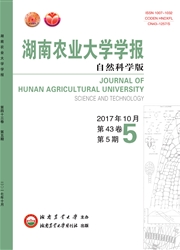

 中文摘要:
中文摘要:
以云烟100(耐铝)和云烟105(铝敏感)为材料,采用水培法研究外源一氧化氮(NO)对铝胁迫下烟草植株生长、叶片活性氧含量、光合特性、叶绿素荧光参数、光呼吸和抗氧化酶活性的影响。结果表明,铝胁迫显著降低了烟草叶片叶绿素含量、净光合速率(Pn)、最大光化学效率(Fv/Fm)、PSII光合电子传递量子效率(FPSII)和光化学猝灭系数(q P),提高了反应中心PSII过剩激发能,从而导致叶片超氧阴离子(O2·)和过氧化氢(H2O2)含量升高,植株生物量下降。外源NO可显著提高铝胁迫下烟草叶片叶绿素含量、Pn、Fv/Fm、FPSII、q P和植株生物量,降低反应中心PSII过剩激发能和叶片O2·、H2O2含量,且云烟105变化幅度高于云烟100。此外,外源NO还显著提高了铝胁迫下烟草叶片非光化学猝灭系数、光呼吸速率、超氧化物歧化酶和抗坏血酸过氧化物酶活性,说明NO可通过提高烟草叶片光化学反应能力、热耗散、光呼吸以及抗氧化酶活性来降低反应中心PSII过剩激发能,防止或清除叶绿体内产生的活性氧,缓解铝对烟草的毒害,这种缓解效应在敏感基因型云烟105中表现更明显。
 英文摘要:
英文摘要:
The effects of sodium nitroprusside(SNP, an exogenous NO donor)on aluminum(Al)toxicity in tobacco were studied by investigating plant growth, reactive oxygen content, photosynthesis, chlorophyll fluorescence characteristics, photorespiration and antioxidative enzymes in leaves of tobacco cultivar Yunyan 100(Al-tolerant)and Yunyan 105(Al-sensitive)with solution culture method. The results showed that under Al stress, the leaf chlorophyll content, net photosynthetic rate(Pn), maximal photochemical efficiency(Fv/Fm), quantum yield of electron transport at PSII(FPSII)and coefficient of photochemical quenching(q P) were dramatically decreased, which increased excess energy of PSII photochemistry leading to higher accumulation of O2· and H2O2, and lower plant biomass in both genotypes. Under Al stress, application of exogenous NO dramatically increased the leaf chlorophyll content, Pn, Fv/Fm, FPSII, q P and plant biomass, decreased excess energy of PSII photochemistry and accumulation of O2· and H2O2, the effects were more predominantly in Yunyan 105 than in Yunyan 100. Furthermore, the coefficient of non-photochemical quenching, photorespiration rate, and activities of superoxide dismutase and ascorbate peroxidase were increased in both genotypes in the presence of NO under Al stress. These results indicated that application of exogenous NO could enhance the tolerance of tobacco to Al stress mainly by increasing of the photochemical reaction capacity, heat dissipation, photorespiration and activities of antioxidative enzymes, which prevents or eliminates ROS accumulation, and the effect is greater in the Al-sensitive genotype than in the Al-tolerant genotype.
 同期刊论文项目
同期刊论文项目
 同项目期刊论文
同项目期刊论文
 期刊信息
期刊信息
